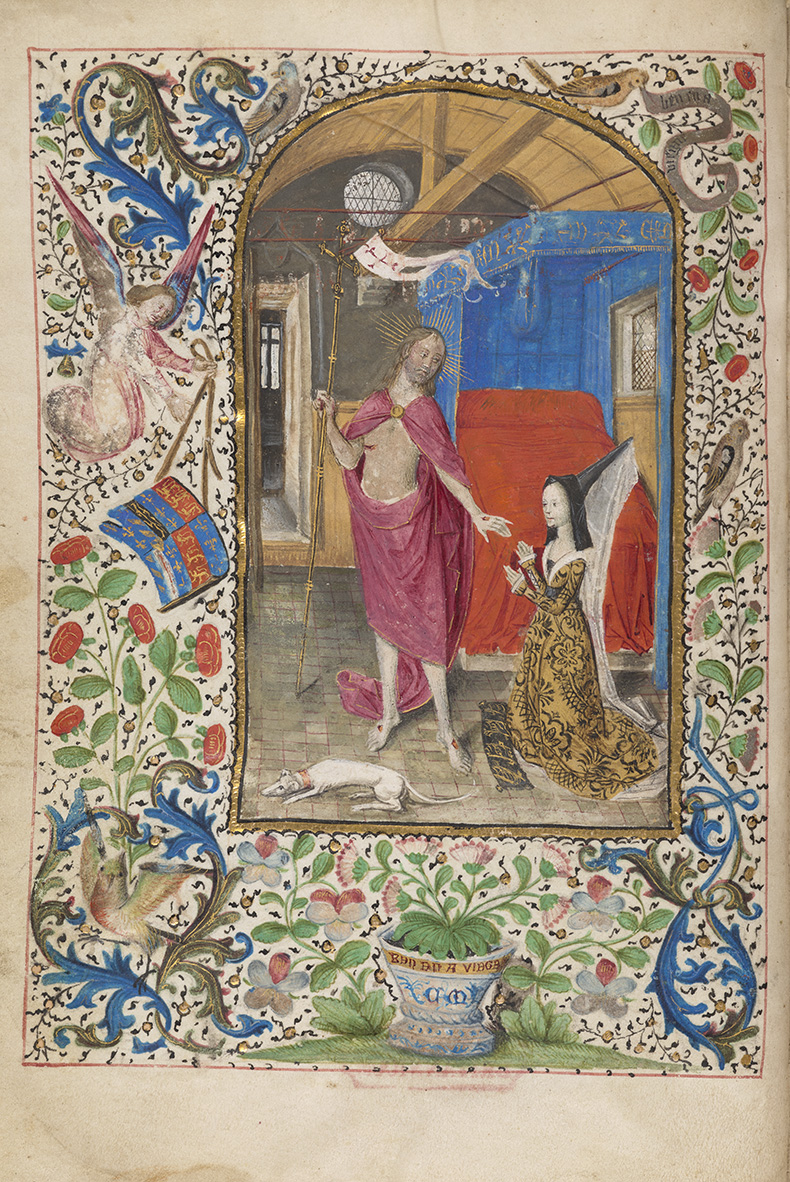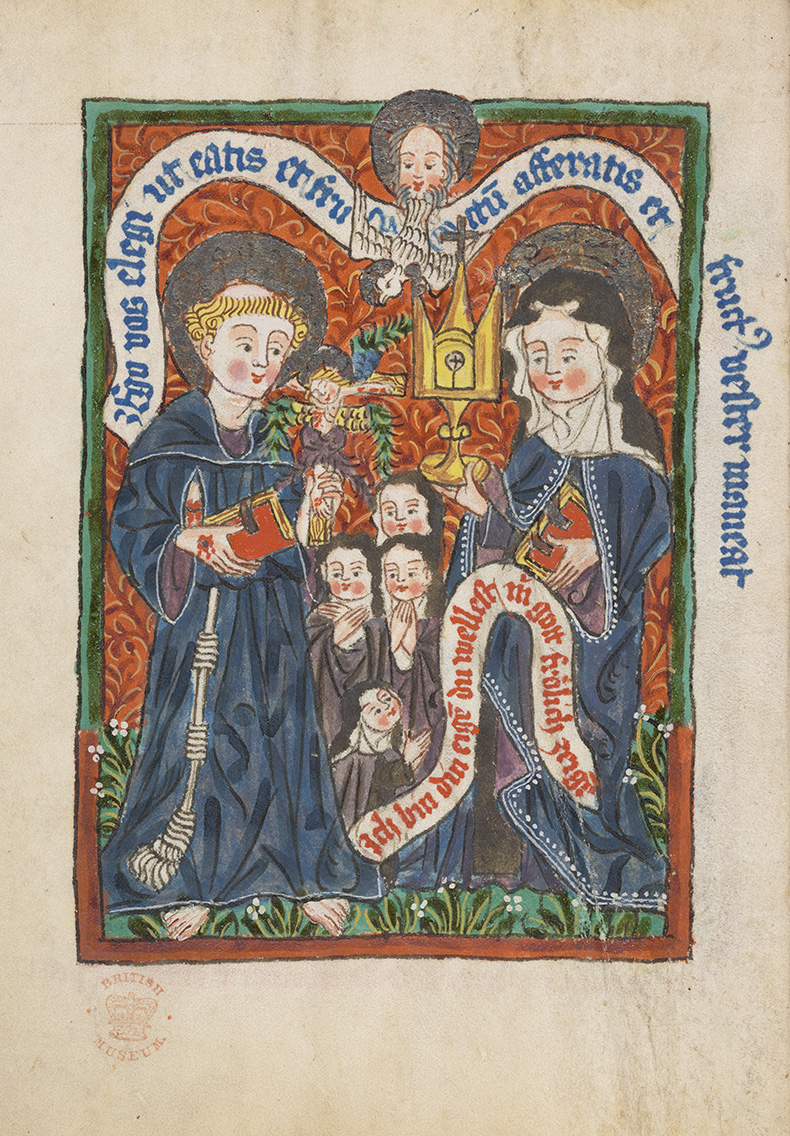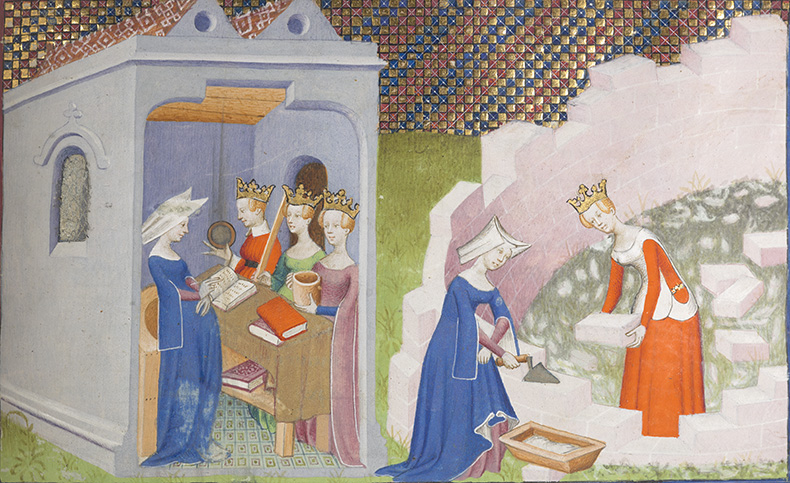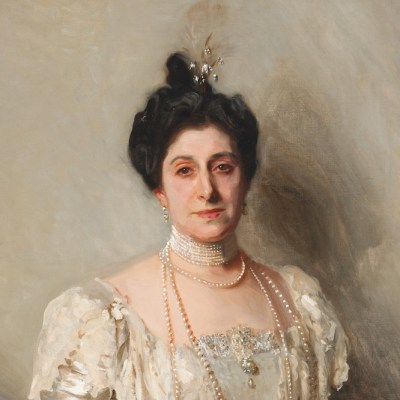From the February 2025 issue of Apollo. Preview and subscribe here.
The women in the British Library’s current exhibition are queens and abbesses; patrons, authors and scribes; saints and silk merchants; farm labourers, sex workers and rebelling peasants. Their voices resound in the lines of manuscripts and archival documents which comprise many of the 140 objects on display, supported by sculptures, coins, ivories, textiles, jewellery, a golden cup and even the skull of a lion (possibly Margaret of Anjou’s pet).
The author and public intellectual Christine de Pizan (c. 1364–c. 1430) greets the visitor at the entrance. Widowed at the age of only 25, with an infant son and an aging mother to support, Christine turned to writing as a way to survive before becoming one of the most outspoken and influential thinkers of her century. She personally supervised the preparation of her Queen’s Manuscript, a richly illuminated, two-volume compendium of her works. In the first scene the visitor encounters in the exhibition, Christine is helping, trowel in hand, to build the walls of the utopian settlement she imagines in her best-known work, The Book of the City of Ladies. Around the corner, in a separate vitrine, the author, in the blue dress in which she is always depicted, holds out her book to a placid-looking Queen Isabeau of Bavaria. As she kneels, with arms extended, the lean of her back reveals the effort of supporting its weight.
Margaret of York kneeling before the Resurrected Christ in the Dialogue de la duchesse de Bourgogne à Jésus Christ (MS 18852, f.288r) (c.1468). British Library, London. Photo: © British Library Board

The exhibition is divided into four sections: ‘private lives’, ‘public lives’, ‘working lives’ and ‘spiritual lives’. The viewer must rely on their own intelligence to make meaningful connections between the artefacts they contain; the objects here have largely been left to speak for themselves, with accompanying labels that describe rather than analyse. There are, however, square blue panels punctuating the sequence of captions on the walls. Each presents a different statistic: 48 per cent of aristocratic English women’s wills included books among their bequests; 26 per cent of women employed in Paris in 1300 worked in the silk trade; between 1100 and 1600, 20 women reigned in Europe as queens in their own right; fewer than 1 per cent of women became nuns; in England, around one in 20 women died in childbirth, and so on.
In one of the vitrines dedicated to women’s health, part of the section on ‘private lives’, a gold ring sits near a parchment birthing girdle and a treatise on the complications of childbirth. Rows of pink roundels, each one filled with a tiny tumbling man, show the foetus preparing to leave the womb. On the girdle, a narrow, curving band inscribed with prayers in red and green script, the paint on a life-size image of Christ’s wound has been rubbed through to bare parchment. Carved roughly into the ring itself is an image of Saint Margaret, patron of pregnancy and childbirth, climbing out of the mouth of a dragon. The baby must also emerge, of course, but this talisman is for the mother.
Turning away from the artefacts of domesticity, of private bodies and private prayers, the objects in ‘public lives’ hint at private passions lived out on grand, dynastic scale, of history writ large. Minutely carved scenes of violence and mercy fill the ivory plaques that once served as covers to the psalter of the formidable Queen Melisende of Jerusalem (1105–61), who defended her throne first against husband, then son. At the top of one panel, a personification of Faith – hair flying, skirts swinging – kicks Idolatry in the neck.
Saint Francis and Saint Clare in The Rule of the Minorite Order of Sisters of St Clare (MS 15686, f.1v), illustrated by Sibylla von Bondorff. British Library, London. Photo: © British Library

Private, public and working lives come together in the final section on ‘spiritual lives’. In the books and letters featured here, abbesses have provisions to buy, buildings to repair, land grants to administer and clothing to bless. Making textiles and producing books were the financial backbone of some communities; the nuns’ skilled labour was regarded as an extension of prayer. The peace of the convent could not be taken for granted. At Dartford Priory, the faces of all the saints on a wooden retable (c. 1400) were scratched away during the anti-Catholic violence of the 1540s. The sword that skewers Saint Agatha’s breasts like a cocktail stick piercing an olive is scarcely more shocking than the wood grain that shows through where her face should be.
Multimedia displays, many interactive, offset the large number of written artefacts. Earpieces resembling those of antique telephones play a selection of popular songs, courtly verse and the compositions of Hildegard of Bingen. There is a video of an archaeologist presenting the skeletal remains of a 15th-century recluse who suffered from arthritis and syphilis. One touchscreen quiz asks, ‘Are you a witch?’ Smell cabinets reproduce the sensory experiences described by medieval mystics. To this visitor, Margery Kempe’s heaven smelled of apples, fresh picked and musty. The fire and brimstone in Julian of Norwich’s hell suggested burnt tyres and licorice; this scent proved not only pungent but also durable, and wafted through the displays on spiritual life.
At times, the galleries feel like a gathering of celebrities, with Heloïse, Marie de France, Joan of Arc and Queens Mary, Margaret and Eleanor all walking the red carpet. Other displays bring us closer to ordinary women. A parchment scroll tallies the debts of money-lender Licoricia of Winchester who was murdered in 1277. A clerk’s hand immortalises Margaret Starre, who threw aloft the ashes of burnt manuscripts and cursed the learning of clerks during the Peasants’ Revolt of 1381. On 7 February 1450, Marta, age 22, was sold in Venice to a Florentine merchant for 36 gold ducats. The creased, browned paper on which this event was recorded has been affixed to the back wall of its case and extra space cleared around it. The effect produces a moment of silence, a gesture of remembrance for names forgotten and voices unheard.
From the February 2025 issue of Apollo. Preview and subscribe here.
‘Medieval Women: In Their Own Words’ is at the British Library, London, from 25 October 2024–2 March.



